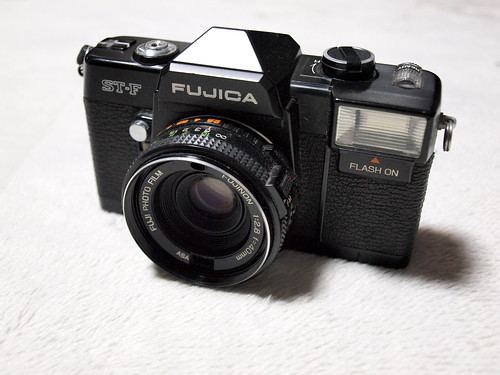Fujica ST-F

|
| image by tkhs2525 (Image rights) |
The Fujica ST-F was a circa-1975 attempt by Fuji to create a crossover between the features of an SLR and a simpler point & shoot (more than a decade before the concept of the "bridge camera" flowered with models like the Chinon Genesis). The 40mm f/2.8 lens cannot be removed, film advance is by simple thumbwheel, and a CdS cell reads the scene brightness from above the lens (not through it). The exposure is set by turning the aperture ring until the green LED is on. The behind-the-lens mirror shutter is "programmed" in that its speed is coupled to the aperture setting. A built-in flash is included.
The mirror shutter is different from those found on the Exa or the Pilot Super. Instead of having a second blade moving up to close the shutter, the mirror itself returns immediately to end the exposure. The shutter speed is set by limiting how far the mirror can flip up before it returns. Here is how it works: a pair of levers located at the back side of the lens board open and close like scissors. The movement is coupled to the aperture ring. The top lever is the mirror stopper. The larger the aperture opening, the larger angle the mirror can flip up, and thus the longer exposure time. The bottom lever covers part of the lens opening to match the part covered by the mirror -- to make the exposure more even. The light passing though is further limited by a flap hinged between the lower edge of the mirror and the inner-bottom side of the mirror box. The flap has a pentagon shaped hole in the middle. It acts as a light baffle.
The ST-F was probably made for Fuji by Sedic. The Great Wall PF-1 is a direct copy of this camera, made in molded plastic. Other variations are known as Aviva PF-1, Yumica RFX-1, Naigai SRF, Bell & Howell RFX-1.
Links
In Japanese:

|
| image by Renaldy Fernando Kusuma (Image rights) |